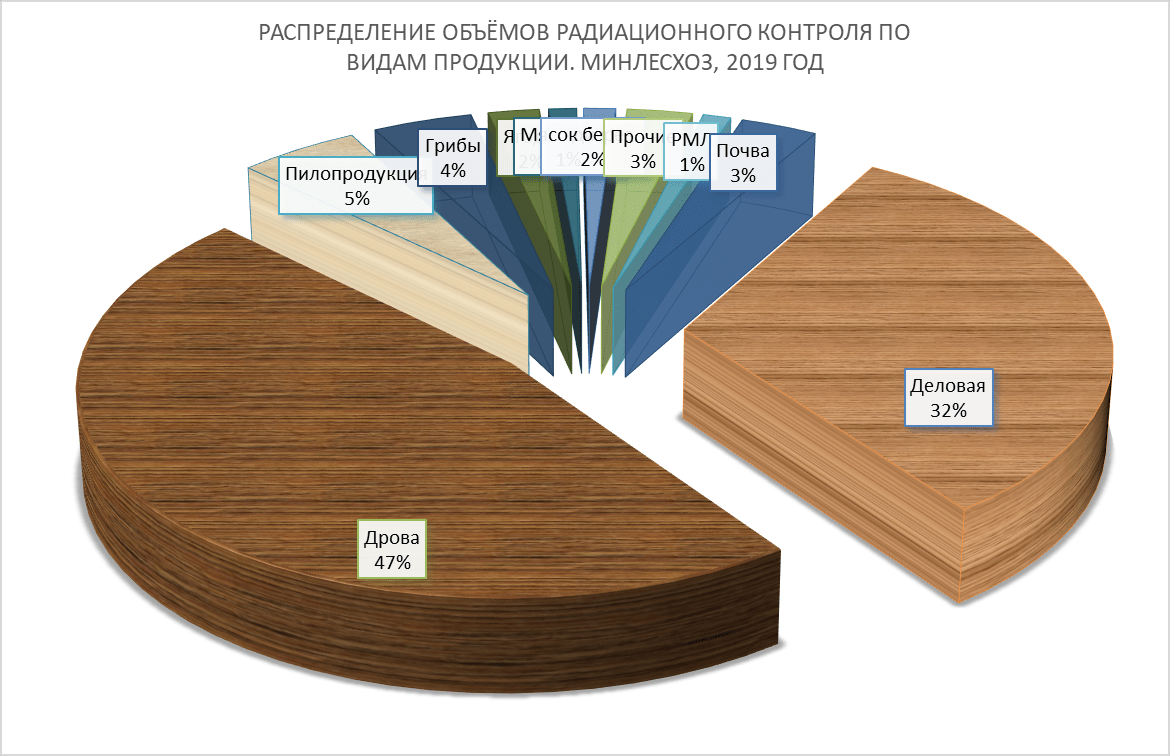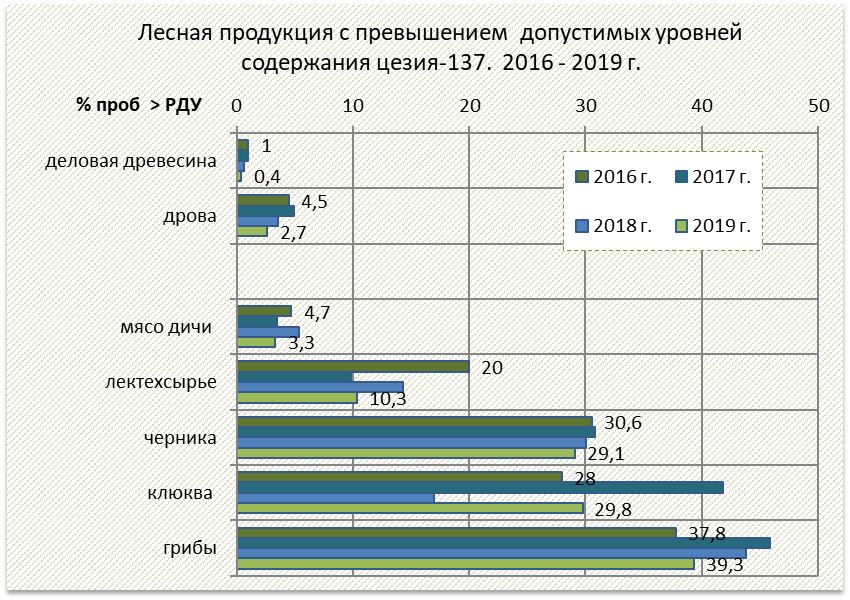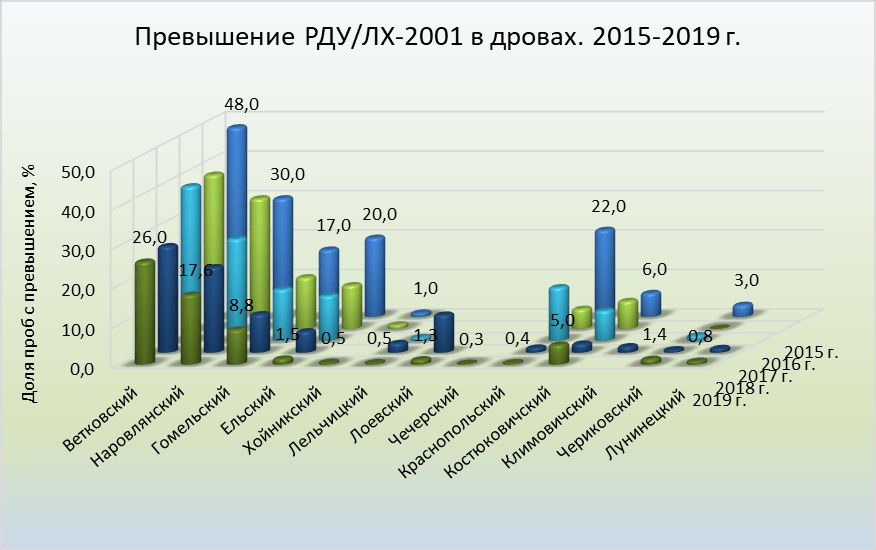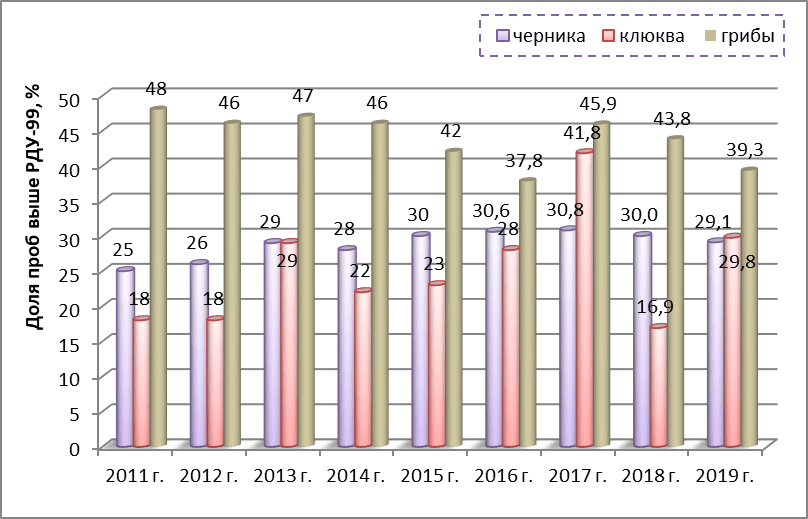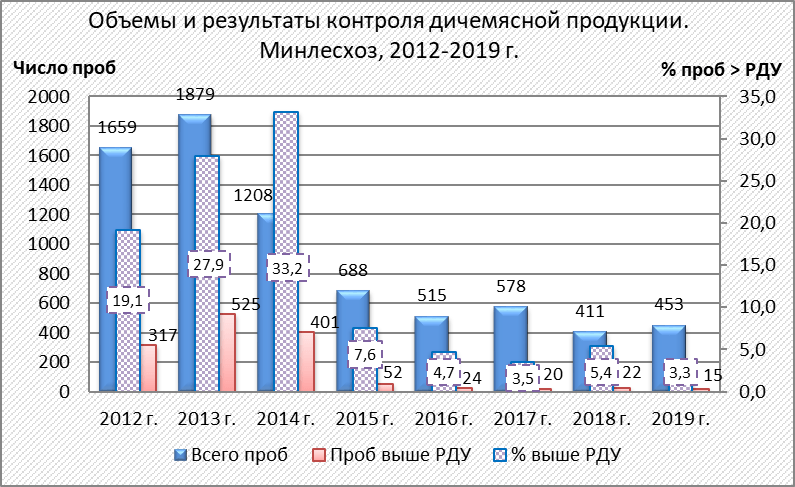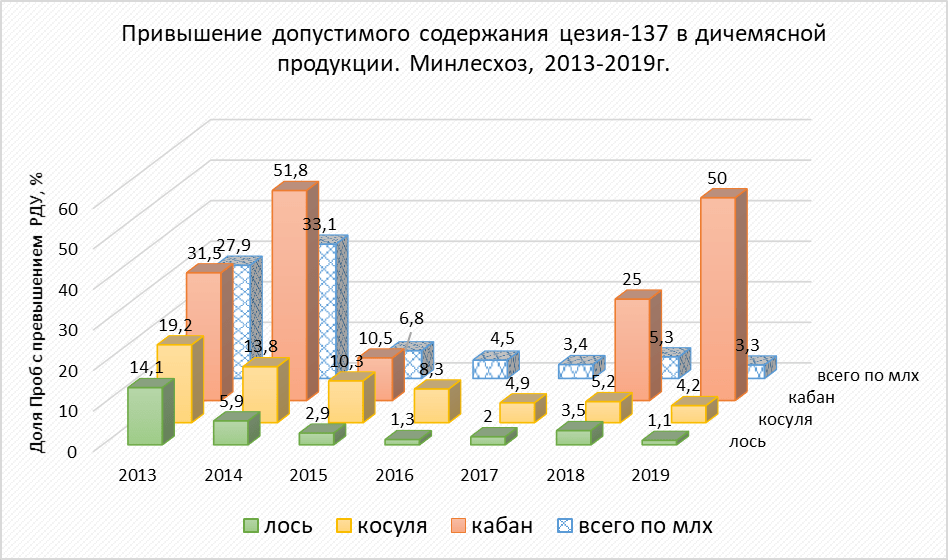Radiation Monitoring
The forest fund radioactive contamination control system includes two subsystems: radiation control and radiation monitoring. The control of radioactive contamination in the forests is carried out by the radiation control service of the Ministry of Forestry, which includes 36 accredited and certified structural units that carried out the full range of work in 44 forestry enterprises in the industry. The objects of radiation control are: forest fund lands, forest fund plots and forest resources, forest products – business wood and firewood, forestry facilities and workplaces.
Distribution of radiation monitoring volumes by type of product. Ministry of Forestry, 2019
During 2019, the leskhoz conducted radiation monitoring of harvested and marketed forest products, primarily wood and wood products, as well as forest food products – birch sap, mushrooms, berries, honey. A total of 37927 samples were measured, including 36257 samples of forest products (95.6%), 1493 – soils, 870 – others.
In the total volume of controlled forest products, wood and wood products make up 90.2% (32969 samples), including: 30176 samples of commercial wood and firewood, 1945 – sawn timber. The content of cesium-137 radionuclide in forest food products was measured: 1610 samples of mushrooms, 829 berries, 453 samples of game animals, 516 samples of birch sap.
The main volume of controlled forest products – wood taken from cutting areas – is accounted for by forestry enterprises of the Gomel and Mogilev State Forestry Enterprises (92.5%), in which cases of exceeding the permissible levels of cesium-137 in industrial wood (1480 Bq / kg) – 1.0 and 0.1%, wood (740 Bq / kg) – 5.53 and 0.9%, respectively.
The share of controlled samples of forest products exceeding the permissible levels of cesium-137 decreased for most species, remained at the same level for blueberries, wild mushrooms, and wild meat products. Radiation monitoring of berries and mushrooms is carried out in territories in the I zone (1-5 Ci / km2), recommended for their collection. The content of cesium-137 in mushrooms collected at a density of more than 5 Ci / km2, in most cases (up to 80%), exceeds the permissible level (370 Bq / kg). with a maximum excess of 62 times (22828 Bq / kg).
A significant percentage of samples (up to 40%) with an excess of RDU-99 in wild berries and mushrooms has remained virtually unchanged for many years, due to the stably high specific gravity of cesium-137 in forest litter and upper mineral soil layers (up to 70% of the total stocks of cesium-137 in forest soil).
Wood radiation monitoring
In total, during the year 2019, 5,200 cutting sites were examined on the territory of the radioactive contamination of the forest fund. As a result of the radiation examination, the levels of cesium-137 in wood (commercial wood and firewood) of various species were established, their compliance with the acceptable levels of hygiene standard RDU / LH-2001.
The main share of wood with a cesium-137 content of more than 300, 740 Bq / kg falls on the territory of the forestry enterprises of the Gomel and Mogilev GPLHO. On average, 82% of wood in Gomel GPLHO is contaminated with cesium-137 with an activity of less than 300 Bq / kg, in Mogilevsky 90%.
It should be noted that in most forestries with forest fund territories in areas of radioactive contamination, it is possible to supply wood fuel that meets the requirements of consumers. In 2019, in 19 out of 44 forestries (43% of all “contaminated”), the specific activity of 137Cs in wood did not exceed 200 Bq / kg, in 26 (59%) – 300 Bq / kg.
Exceeding the permissible levels of cesium-137 in wood was established on the territory of the forest fund in the zones of radioactive contamination of 11 leshozes – Gomel GPLHO (7 leshozes), Mogilev (3) and Brest (3, Luninetsky leshoz, 3 samples of firewood).
Mushrooms, berries and game meat
Radioactive contamination of wild berries and mushrooms, meat of game animals remains at a high level and 34 years after the Chernobyl accident. According to the results of radiation monitoring, the highest values of specific activity of cesium-137 and the proportion of samples exceeding the permissible levels of RDU-99 were established for these types of products throughout the forest fund with a pollution density of 1 Ci / km2 or more. The maximum levels of cesium-137 in mushrooms remain the highest in the forestries of Gomel (578 Bq / kg – average and 10,472 Bq / kg – maximum) and Brest GPLHO (799 Bq / kg and 10,403 Bq / kg). The activity of cesium-137 in blueberries did not exceed 2251 Bq / kg, cranberries – 960 Bq / kg.
One of the types of controlled products is the products of hunting – the meat of game animals caught in forest hunting enterprises with territories of hunting grounds in the zones of radioactive contamination. Since 2015, the volume of controlled wild boar samples has significantly decreased due to the introduction of a ban on hunting for this species, and as a result, the number of samples has exceeded the permissible level (RDU-99).
The content of cesium-137 in the meat of hunting animals depends on the species, diet, habitat. As a rule, wild boar meat is the most contaminated with cesium-137, and the elk, roe deer, and deer are the least contaminated. The most “clean” forest food products include birch sap – with an average cesium-137 content of 11 Bq / kg (maximum 101 Bq / kg) at a rate of 370 Bq / kg, the cesium-137 content in honey harvested from forestry beekeepers did not exceed 188 Bq / kg with an acceptable level of 3700 Bq / kg (average value – 21 Bq / kg).

